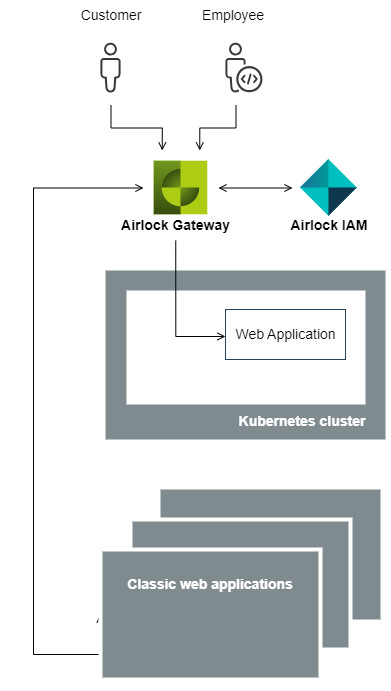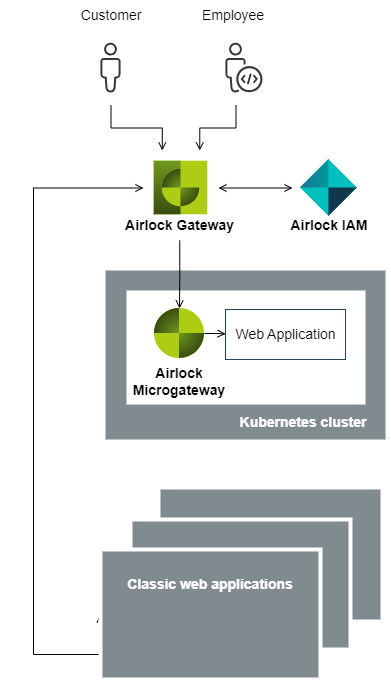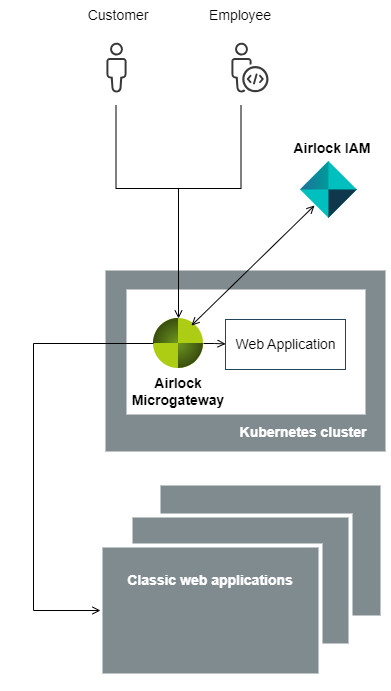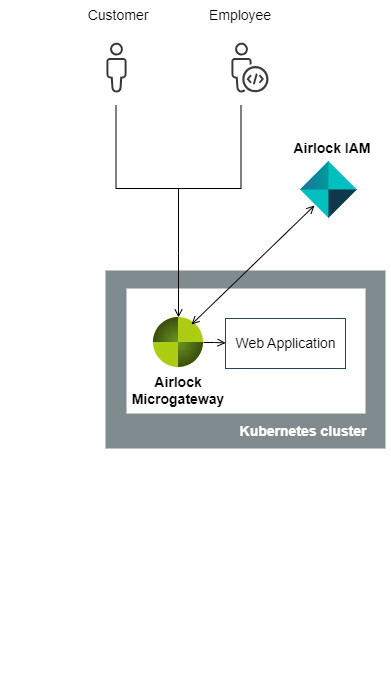System architectures
The purpose of this article is to describe the differences between the components Airlock Gateway and Airlock Microgateway and how they can be combined for optimal synergy. The combination of both components allows different architectures which have their pros and cons. This article provides you with information to make a decision about which architecture is best for you.
Note that Airlock IAM is illustrated as a separate component outside Kubernetes to enhance clarity – this is not a requirement. Airlock IAM can also be deployed as a pod in Kubernetes and still serve both Airlock Gateway and Airlock Microgateway. However, with the focus on Airlock Microgateway, this aspect is not further discussed here.
Depending on your decision for the overall system architecture, an Airlock Gateway may or may not be positioned in front of the Kubernetes cluster. This manual focuses only on the deployment of Airlock Microgateway inside the Kubernetes cluster (e.g., deployment in OpenShift or Kubernetes, with or without service mesh, ...) and does not discuss the placement nor functionality of the Airlock Gateway. This has been done to simplify the manual and does not imply any additional meaning.
Characteristics of Gateway and Microgateway components
Both Airlock Gateway and Airlock Microgateway have distinct characteristics. One or the other may be preferable in different architectural environments. Consult the following table to find the best match for your project. Also, mind the section Data plane modes of Airlock Microgateway in this article.
Airlock Gateway | Airlock Microgateway | |
|---|---|---|
Architecture |
|
|
High Availability |
These functionalities are built-in, except for the external checks. |
Kubernetes built-in functionalities are used. Microgateway supports the required integration. |
Configuration interface |
|
|
Scriptable |
|
|
GitOps friendly |
|
|
Security model |
|
|
Configuration agility | Suited best to the following change frequencies:
| Suited for any change frequency:
|
Airlock version |
The same Airlock Gateway version is used for all web applications. | Data plane mode
|
Bundle web application with Airlock |
Because Airlock Gateway is shared, at least the Gateway version can not be bundled to a particular web application version. |
Bundling a certain Airlock Microgateway configuration with a particular web application is possible. |
Configuration maintained by |
|
Shared responsibility. |
Enforcing security settings |
|
The security team can enforce settings and control who has access to which Custom Resources in case different teams maintain the configuration. |
Security know how |
| Depending on team responsibilities and processes the security policies can be configured in a centralized or decentralized way (or even a mix of it).
Must likely the security team is still responsible for the overall security, also if the policies are configured decentralized in the teams. But in such case security know-how must also be present in other teams as well. The security team enables them with templates, guidelines and education. |
Processes |
|
|
Data plane modes of Airlock Microgateway
Airlock Microgateway can be deployed in two data plane modes: sidecar to extend an application Pod with security or sidecarless with the Kubernetes Gateway API.
The following comparison chart lists the important differences between both data plane modes and can be used as a decision helper to select the best matching mode for your requirements:
Data plane mode: | ||
|---|---|---|
Sidecar | Sidecarless with K8s Gateway API | |
Total resource consumption (CPU/Memory) | Low | Even lower |
3rd party solutions licensing number of containers (e.g. DataDog) | Higher 3rd party license costs. | Lower 3rd party license costs. |
Airlock Microgateway CNI plugin | Required | Not required |
Supported service mesh compatibility | Istio and Cilium | No special compatibility requirements. |
Update Microgateway Engine | Rollover of the application Pod. | Rollover of Microgateway (no impact on the application). |
Traffic filtering with Airlock Microgateway | Automatically in-line (traffic is redirected first to Microgateway). | Filtering ensured with routing and network policies in Kubernetes. |
Protected web application | Runs inside of Kubernetes. | Runs inside or outside of Kubernetes. |
North-South traffic | Yes, for the protected Pod. | Yes |
East-West traffic | Yes | Yes, by routing the traffic accordingly. |
Which architecture should I use?
Depending on your needs, a particular architecture blueprint will be best suited for you. The table below provides some arguments for the different architectures and should assist you in the decision-making process.
For simplicity, drawings showing the Airlock Microgateway only show the sidecar-based data plane mode.
Architecture A | Architecture B | Architecture C | Architecture D | |
|---|---|---|---|---|
Applicable Airlock Microgateway data plane modes |
|
|
|
|
Strengths of the different architectures |
|
|
|
|
Baseline vs. fine-grained security
The idea of baseline security is to have a basic set of general security settings enforced for all web applications. These settings should be generic and have a long lifecycle, i.e., they will not change much when upgrading applications. An example of a baseline security setting is the public TLS cipher configuration.
Fine-grained security settings, however, are tightly coupled to a specific web application and enable strict security policies. These settings bring in-depth security and protect the web application from serious attacks. They are usually specific to a web application and may therefore change with new application versions. An example of a fine-grained security setting is an OpenAPI specification for API calls.
It is not recommended to expose web applications to the Internet only with baseline security applied.
Depending on which architecture you have chosen, the baseline security settings are configured in different components. If Airlock Gateway is in front of the Kubernetes cluster, it takes care of baseline security. It has the advantage that, since only the security team can modify the configuration, these settings are easily enforced.
If no Airlock Gateway is installed in front of the Kubernetes cluster, baseline security will also be handled by the Airlock Microgateway. Enforcement requires correct use and setup of Kubernetes tooling (see Enforce policies).
The list below provides some hints on what kind of setting is more part of baseline or fine-grained security.
Baseline security
| Fine-grained security
|



